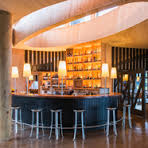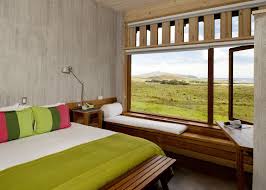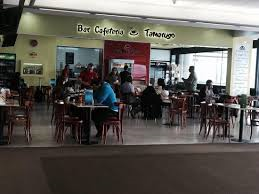My spouse and I took three excursions with
Far South Expeditions (FSE) in late March-early April 2017. We found this
company when we searched online for an agency in Punta Arenas that offered
private excursions to visit the king penguins in Tierra del Fuego, as well as an
agency that offered condor viewing. In addition, we took one other widely
available trip with Far South Expeditions to Islas Magdalena and Marta.
Cecilia, the representative whom we dealt with online and via email, was
friendly, adept, and professional. When we booked with Far South, she promptly
sent us an invoice to pay a deposit (approximately 30% of the total), then
about 30 days prior to our trip, she sent us a final invoice so that we could
pay the balance. Descriptions of our excursions follow.
Condor Viewing: Because it is best to take
this excursion in the afternoon (and because our time in Punta Arenas was so
limited), we requested that our guide and driver pick us up at the Punta Arenas
Airport when we first arrived to the city, rather than transferring to the
hotel (about 25 minutes) and then re-tracing our path back past the airport. We
informed Cecilia about the luggage we would carry, and she arranged an
appropriately sized vehicle. Our guide Bastian was waiting for us at baggage
claim holding a sign with our names on it. We wheeled our bags out to the curb
as Bastian called the driver. (We were surprised that Bastian did not offer to
assist us, as other guides normally do.) Then we took a 1-hour drive northwest
to Estancia (Ranch) Olga Teresa in Rio Verde to view the condors at Cerro Palomares (“Dovecotes
Hill”). We first met the property owner at his house, where he has restroom
facilities for guests. Then we drove a short distance by car and parked near
the main condor-viewing area. From the parking area, it was a short 5-minute
uphill walk to the observation area, which had additional restrooms and benches
for viewing that are used by tour groups. On foot, we continued to walk uphill
for about 10 minutes to a spot closer to the condor nests. The owner set up a
high-powered spotting telescope, and we took turns looking at two condors
perched on the rocky cliffs above us. Unfortunately, although it was a lovely,
cool, and sunny day, there were no thermal winds, so we saw very few birds.
This excursion would have been better had we seen more condors, but as with all
wildlife, sightings are not guaranteed. Later on our trip to Patagonia, we had
a chance meeting with a flock of about 50 condors flying overhead, and it was a
fantastic sight! However, it was so uncommon an encounter that even our
experienced guide was amazed. If flocks that large are common on Far South’s condor
excursion, then it is definitely worthwhile to spend the time and money. (Note
that there are absolutely no services [gas stations, restaurants] on the drive
to and from the condors, so bring whatever you need with you.)
King Penguins of Tierra del Fuego by Air:
Bastian and the driver picked us up at our hotel, and we drove to the Punta
Arenas Presidente Carlos Ibáñez del Campo International Airport. We
checked in at the counter for our airline Aerovias DAP, and the airline
representative gave us our boarding passes. We easily passed through security,
for we were travelling light because it was a day trip. We waited in the
domestic “national” departures area, which is surrounded by glass walls and
doors adjacent to the regular departures area. Unfortunately, our flight was
delayed due to fog; because a small prop plane is used to travel the 12-minute
flight from Punta Arenas to Porvenir, it operates by visual flight rules. (An
alternative version of this excursion to the king penguins travels to Porvenir
by ferry, which takes approximately two hours each way.) When we arrived at the
Porvenir Airport, our driver David picked us up and drove us to his home (Hosteria Yendegaia)
for refreshments, restrooms, and a short break before we began our drive. The
reason for this stop seemed unnecessary until we realized that the penguin preserve
does not open until 11:00 am, so we were just wasting time; we wish that
Bastian had been honest with us and told why in advance, or even given us an
idea of how long we would spend at David’s so that we could use our time more
wisely. But the time passed quickly, and eventually we were on our way. Note that
there are no services (like gas stations or restaurants) on the two hour drive (each
way) between Porvenir and the research facility – perhaps a few estancias, but
little signs of civilization other than an occasional bus stop enclosure.
David’s car got a flat tire on our return journey; fortunately he travels with
a full-size spare or we would have been stranded for hours. (We shudder to
think what would have happened if more than one tire was flat!). Keep in mind
that you will not get too close to the penguins – you will view them across a
small pond primarily through viewing holes cut in a long plywood wall. The park
sets up a few rudimentary magnifying boxes near the holes to help see them.
About 50 penguins were onsite (which is the usual number), and we were lucky
that the flock still had 5 or 6 youngsters. Most chicks hatched in February and
had already grown to adult size (of 3.5 feet tall), so they were difficult to distinguish
from their parents; however, a few late bloomers (who were already 2 feet tall)
still sported their brown fuzzy feathers. The sanctuary offers restrooms (just follow
the rules and don’t flush the paper), a small gift shop, and a few picnic
tables where we ate our box lunch. (When we saw the contents of the box lunch,
we joked that it seemed like something that an 8-year old child would pack in
terms of all of the junk food included. Each large shopping included a sandwich
(tuna fish), an apple, and a bottle of water, but it also included a juice box,
a small can of potato crisps, two granola bars, two chocolate candy bars, and a
package of chocolate cookies!) In the parking lot was a bus that had been
converted into a sort of café, but it was not open on the day that we visited
(so late in the season). Staff (researchers) live onsite in modular trailers.
After spending about 2 hours at the preserve, we drove back to David’s
home/hotel, where we relaxed for about 45 minutes. Again, we wish that Bastian
or David had let us know the departure time for the airport; we would have
preferred to walk around the small town, perhaps to the nearby Plaza de Armas main
square, rather than sit in the living room/lounge area of his house while
biding time. (Fortunately, the house displays lots of interesting handicrafts,
as well as books, so there is plenty to look at while you are waiting.) We
arrived at the airport for our
return flight much too early. With such a small plane, it takes no time to
check in, and security is literally non-existent. The airport building is new
and modern, but it lacks anything to occupy your time. Except for restrooms, it
offers no amenities: nowhere to buy a souvenir, drink, or snack (not even a
vending machine), and no TV or reading material. (We saw a VIP lounge on the
second floor, but no one was permitted to use it.) Although this was a long
day, we loved seeing the penguins – and it must be amazing to visit during
“prime time” when the chicks are hatching. But Far South could improve this
excursion by including some basic Porvenir sightseeing, such as or the seafront
Parque del Recuerdo, Cerro
Miradór, and Plaza de Armas instead of waiting around at the Hosteria.
Penguins of Isla Magdalena/Marta: Bastian and
a random driver picked us up at the hotel and drove us about 15 minutes to the
pier at Bahia Laredo (Laredo Bay). Note that this is not a public dock, and it
offers no shelter, restrooms, or services. The area is enclosed by a chain-link
fence, with a bit of gravel outside on which to park and a wooden platform
extending out over the water. Most guests arrive on the excursion shuttle bus
from Punta Arenas; however, if you drive, look for the small wrecked boat
outside of the gate (there is no sign/placard). Neither the boat nor the
gangplank is handicap-accessible; we had to climb up and down a regular house ladder
(the type that you might use outside your own home to access your roof), which
really seemed unsafe. Conversely, we were asked to wear life jackets, and the
boat guide provided a quick safety briefing. Even though it was late in the
season, our boat was filled to capacity with about 30+ people and 2 crew (the captain
and the guide). Bastian set our pickup time to arrive at the boat dock much
earlier than necessary, and although the weather was cold and misty, he
dispatched the driver he had hired so that we had to stand out in the inclement
weather for nearly 30 minutes until the boat was ready to load. For the price
that we paid, we should have been permitted to wait in the vehicle until
embarkation time. He also did not call the driver when we were approaching the
dock, causing us to wait near the dock for our transportation to return after
all other customers had departed. We took this trip very late in the season,
when most of the penguins had already migrated to other locations. We saw the
majority of penguins right as we approached the island, nearly 50 penguins in
total, primarily in two large groups scurrying over the rocks and preparing to
enter the water. On land, we saw a very few others (perhaps 5 in total) still
in burrows around the island. Once you dock, you walk on a designated pathway
(although not paved) that climbs in elevation around the perimeter of the
island. Even the rangers had departed for the season, so what we thought were
portable restrooms were shuttered, as was the lighthouse. Even the boat captain
said that we were probably one of their last tours of the year. We saw a lot of
dead seabirds (and one dead penguin) strewn around the island, so be prepared
for that grim (yet unavoidable) sight; however, if you visit at a busy time,
you probably won’t even notice. If you were to visit during prime viewing
season, penguins would cross your path as you walk, which would be incredible!
After walking on Isla Magdalena, the boat captain piloted us to Isla Marta,
where we could not disembark, but we could still observe the sea lions
frolicking in the surf and on the shore by climbing on top of the boat and by
peeking out the front and rear hatches/doors. (FYI, the cozy boat has a very
tiny restroom “head”, although we did not see anyone attempt to use it.) On the
return voyage, the crew served hot chocolate and cookies. The excursion to
Magdalena and Marta was easy enough that we could have organized it ourselves;
locating the boat dock may have been a bit tricky, so an alternate solution
would be to arrange the trip directly with the provider, Solo Expediciones, who
offers a small mini-bus transfer from Punta Arenas. Having our guide Bastian with
us was of absolutely no benefit whatsoever. In fact, on the trip to Magdalena
Island, Bastian spent time talking to younger (and more attractive) customers, answering
their questions, and loaning them his binoculars rather than walking with us, his
paying customers. recommend this excursion, but be sure to do it at the
appropriate time of year and with the proper vendor.
Overall, Bastian was knowledgeable, but he
was not forthcoming with information. He communicated when we questioned him,
but he did not offer details unsolicited. We spent a lot of time in cars with
him, but rather than tell us things about his country or what we were going to
see, he read his Kindle electronic book or conversed in Spanish with the
driver. He also did not provide the kind of courteous “hand-holding” that most
guides do to ensure that we were comfortable, that we had water to drink,
whether we needed to use the restroom, and so on.
Suggestion for Far South Expeditions: Please
provide each private tour participant with binoculars, or at a minimum, suggest
that they pack their own pair. We were shocked as we drove to our first
excursion, when our guide asked if we had our binoculars, and he seemed
genuinely surprised when we said that we did not. Had FSE suggested that we pack
binoculars, we actually had a brand-new pair (with camera capability) back home
in the United States that we would have gladly brought along!














































































